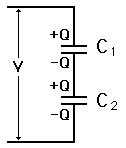Ok, I want to calculate it anyway .
.
We have:
C1 (now in series) which is 0.0235F with a charge of 0.0235F @ 20V = 0.47J
C2 which is 0.094F with a charge of 0.094F @ 10V = 0.94J
To find the final voltage:
Ctot.= 0.0235F + 0.094F = 0.1175F
Qtot.= 0.47Q + 0.94Q = 1.41Q
Vtot. = 1.41Q / 0.1175F = 12V
So you were right, even if we were not talking about the same exact setup.
This confirms the loss I am seeing by measurement.
regards,
Mario
 .
.We have:
C1 (now in series) which is 0.0235F with a charge of 0.0235F @ 20V = 0.47J
C2 which is 0.094F with a charge of 0.094F @ 10V = 0.94J
To find the final voltage:
Ctot.= 0.0235F + 0.094F = 0.1175F
Qtot.= 0.47Q + 0.94Q = 1.41Q
Vtot. = 1.41Q / 0.1175F = 12V
So you were right, even if we were not talking about the same exact setup.

This confirms the loss I am seeing by measurement.
regards,
Mario





Comment